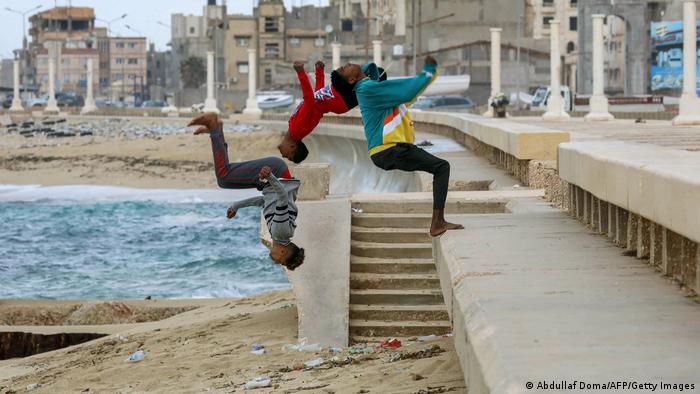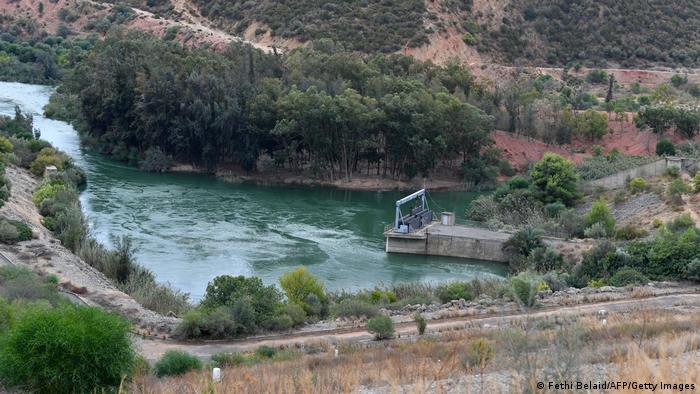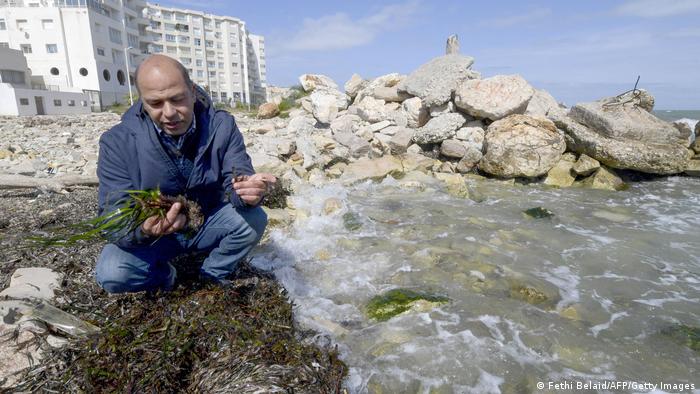[ad_1]
Over the previous 15 years, the fishermen of Ghannouch, a city round 400 kilometers (ca. 250 miles) south of the Tunisian capital, Tunis, say they’ve seen “radical adjustments” on the shoreline they sail round.
“The sand is lowering and the rocks are beginning to seem,” Sassi Alaya, an area seaman and the top of the fisheries guild within the southern port, instructed DW. “It’s a double drawback as a result of the coasts of the state of Gabes are already affected by environmental air pollution as a result of chemical factories within the area. It vastly impacts the work of small fisheries companies.”
“There are black spots across the coasts now,” added Mounir Kcherem, a fisherman from close by Kerkennah island. “There are large variations between the coast right now and the coast 20 years in the past,” he mentioned. “Though this phenomenon continues to be confined to particular locations across the island.”
The fishing households in southern Tunisia are usually not the one ones coping with such adjustments. A latest research by the World Bankthat regarded on the financial penalties of coastal erosion on this space discovered that international locations comparable to Tunisia, Morocco,Libya and Algeria had been dropping their seashores quicker than nearly wherever else on this planet.
Quicker than international common
The research concluded that seashores within the Maghreb area eroded at a charge of 15 centimeters per yr on common between 1984 and 2016. The worldwide common is about 7 centimeters a yr.
It may be arduous to work out how a lot shoreline has been misplaced in a single nation as a result of coasts each acquire and lose sand, so nationwide averages will be deceptive. However it was when World Financial institution researchers used extra detailed information and satellite tv for pc imagery from the European House Company and the Nationwide Oceanography Heart within the UK, that it turned clear simply how endangered the Maghreb shoreline was in sure areas.
Simply over a third — 38% — of Morocco’s seashores are eroding and the nation loses between 12 to 14 centimeters a yr. Libyan coasts are receding by round 28 centimeters yearly. However these are thought-about comparatively secure in comparison with Tunisia. There, a few third — 35% — of sandy seashores are additionally eroding however on the a lot quicker charge of between 50 and 70 centimeters per yr.

An estimated 700,000 persons are employed by Morocco’s fisheries sector
For instance, between 2006 and 2019 in Hammamet, a well-liked vacationer city simply south of the nation’s capital Tunis, the seaside space halved. That equals a lack of about 24,000 sq. meters or between 3 and eight meters yearly, specialists calculated.
World Financial institution economists additionally tried to calculate the worth of such losses by understanding what misplaced land and infrastructure on the coast was price. They discovered these can be equal to about 2.8% of Gross Home Product (GDP) in Tunisia, 0.7% in Libya, 0.4% in Morocco and 0.2% in Algeria. Altogether, this may have been equal to round $2.46 billion (€2.42 billion), on the premise of these international locations’ nationwide revenue from 2021.
Nonetheless, because the researchers additionally famous, “these prices are on the decrease facet as they don’t incorporate different values comparable to foregone revenues from tourism.”
Coastal erosion additionally has an extra knock-on impact: As saltwater encroaches on land, it begins to pollute contemporary groundwater, making it saltier. The brackish water cannot be used for consuming or agriculture.
Socio-economic catastrophe
The potential affect of coastal erosion on sectors like tourism and fishing are like a “socio-economic bomb” ready to go off, the writers of an article printed by HydroSciences Montpellier, a particular laboratory on the College of Montpellier in France that focuses on Mediterranean water sources, mentioned.
“Local weather change amplifies different threats and exacerbates underlying vulnerabilities and social dangers,” Lia Sieghart, the World Financial institution’s apply supervisor for atmosphere and pure sources for the Center East and North Africa, instructed DW. “Marginalized social teams are notably weak to the affect of local weather change. That is why political stabilization and actions on local weather change go hand in hand.”
The scenario in Maghreb international locations can also be extra precarious due to the variety of locals dwelling on or close to the coast. An estimated 40% of the world’s whole inhabitants lives close to the ocean.

Round 80% of Libyans dwell in city facilities, most of that are situated on the nation’s coast
Nonetheless in Morocco, the proportion of locals dwelling near the coast is 65% and in Tunisia, it is round 85%. Most of the Maghreb’s main cities are situated on the coast and in Tunisia, for instance, an estimated 90% of the nation’s financial output occurs by the seaside.
The truth is, the rising urbanization and inhabitants strain at coastlines might be one of many many causes for extra fast coastal erosion. Buildings and people crowd out the pure components that have a tendency to guard in opposition to erosion, comparable to wetlands, crops and sand dunes.
Rising seas inevitable
One other main motive for the disappearing seashores is clearly rising sea ranges. However, as specialists instructed DW, the actual motive why Maghreb international locations are experiencing a few of the worst coastal erosion on this planet may very well lie a lot additional inland.
“If there’s a distinction between the Maghreb and northern Mediterranean international locations, then I feel it is concerning the variety of dams and the variety of rivers,” defined Gil Mahe, analysis director on the Hydrosciences Laboratory in Montpellier, France, who’s presently working on the Institut Nationwide des Sciences et Applied sciences de la Mer, or INSTM, in Tunisia. Erosion is going on quicker right here as a result of “there are usually not a variety of rivers and a variety of dams,” Mahe mentioned.

Tunisia has near 40 dams and is likely one of the most water-stressed international locations on this planet
Research in Tunisia, Algeria and Morocco that examine the historical past of sedimentation close to the place rivers attain the ocean, have proven that the place there are massive dams, not sufficient sand is arriving on the coast, Mahe defined. The pure geomorphological functioning of a shoreline would see sand arrive to bulk up the shoreline, then it might be washed out to sea by marine currents.
Strain on land and at sea
However the Maghreb shoreline is below strain from two components of local weather change. Hotter temperatures are inflicting sea ranges to rise, which encroaches on seashores. It additionally makes excessive climate occasions, that may injury the shoreline with, for instance, floods, large waves and wind, extra frequent.
On the identical time, a heating planet additionally has much less rain, which implies that native authorities in North Africa try to retailer contemporary water wherever they will, so as to present it to that ever-growing coastal inhabitants. This requires extra dams.

Pure buffers in opposition to erosion, comparable to seagrass, are thought-about one of the simplest ways to guard coastlines
It appears like a vicious circle. However Mahe, who’s engaged on varied plans to higher handle Tunisia’s shoreline and make it clear to native authorities precisely what’s at stake, does have some hope. Whereas an increase in sea ranges is now inevitable, he mentioned, there are quite a few methods to minmize dangerous human impacts and higher defend coastlines and to deal with what’s coming, till people and nature “attain a brand new equilibrium,” he argued.
Consultants comparable to Mahe and people on the World Financial institution suggest what they name “built-in coastal administration plans.” These can embody every thing from a better tax on coastal development work and actual property, to the renovation of inland dams that enable extra sand and sediment to circulate towards the coast, to the erection of wind fences on dunes, or replanting crops.
The World Financial institution is helping with a few of these plans within the Maghreb, the group’s Sieghart identified. “It is true that no nation can single-handedly tackle local weather change,” she mentioned. However, she added, native reactions are nonetheless essential as a result of “these may also help adapt and mitigate local weather change impacts.”
Edited by: Anne Thomas
[ad_2]
Source link





